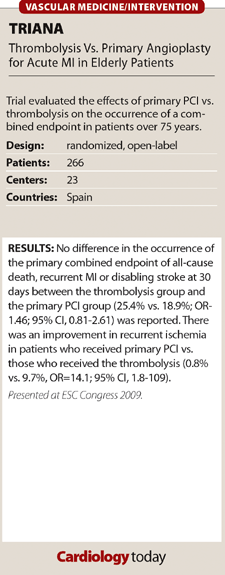TRIANA: Primary PCI comparable to thrombolysis for reperfusion in elderly patients
Recurrent ischemia was reduced in patients who underwent primary PCI.
European Society of Cardiology Congress 2009
A strategy of primary percutaneous coronary intervention in elderly patients with acute MI was associated with trends toward beneficial outcomes when compared with a more conventional approach of thrombolysis plus clot-targeting drug therapy.
The researchers for the TRIANA study enrolled 266 patients aged 75 or older who presented within six hours of STEMI. The trial was prematurely terminated due to slow enrollment before the planned total of 560 participants could be achieved. Researchers assigned patients to undergo either primary PCI (n=123) or a more conservative strategy of thrombolysis plus medical therapy with emergency PCI (n=134). The primary endpoint was a composite of all-cause death, recurrent MI or disabling stroke at 30 days.
According to the study results, there was no difference for the primary combined endpoint of all-cause death, recurrent MI or disabling stroke at 30 days between the thrombolysis group and the primary PCI group (25.4% vs. 18.9%; OR=1.46; 95% CI, 0.81-2.61). There was an improvement in recurrent ischemia in patients who underwent primary PCI vs. those who received the thrombolysis (0.8% vs. 9.7%, OR=14.1; 95% CI, 1.8-109).
“In spite of the sample size limitation, this trial shows a trend towards a lower mortality, reinfarction and disabling stroke in elderly patients undergoing primary PCI compared with fibrinolysis. In addition, recurrent ischemia is dramatically reduced by primary PCI,” the researchers wrote in their abstract. “Therefore, this approach might also be recommended for the oldest patients presenting with STEMI.”

Bueno H. Session 1848-1849. Presented at: European Society of Cardiology Congress; Aug. 29-Sept. 2, 2009; Barcelona.
More News from the ESC Congress 2009 --->
